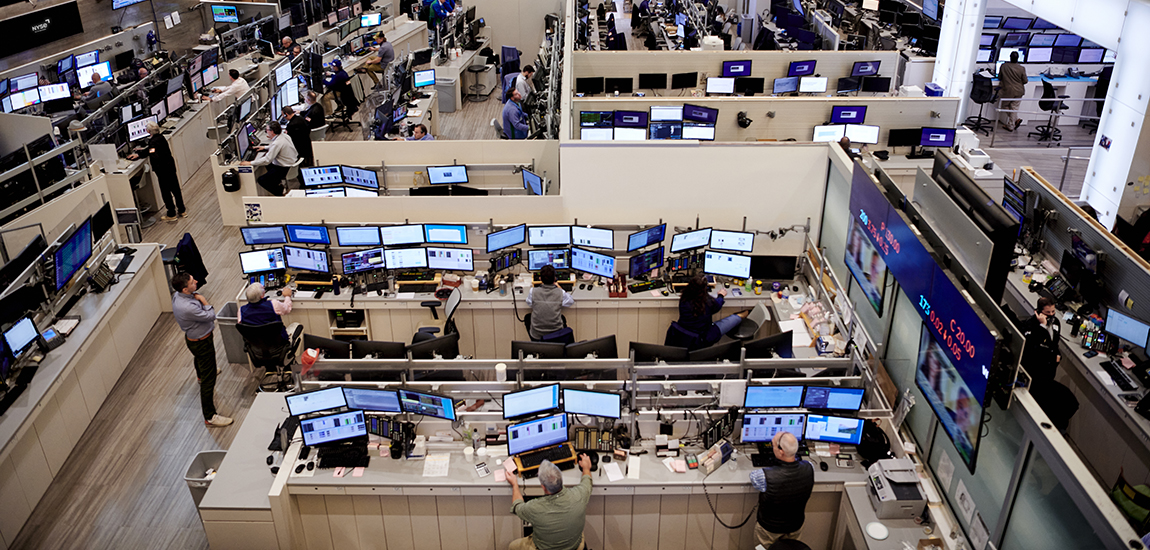
NYSE Options Markets
The NYSE operates two options markets: NYSE American Options and NYSE Arca Options. NYSE options markets have been in business for over 45 years, continuously evolving to meet client needs. NYSE American Options and NYSE Arca Options markets offer differing pricing and allocation models, and each operates active trading floors which connect technology and human judgement.
Connect to Opportunity
Contact us
NYSE American Options offers:
- Pro-rata allocation encourages deep, liquid markets
- Customer orders have priority and pay no fees
- Specialist and/or e-Specialist in most classes
- Allocation entitlement for Directed Market Makers and Specialist pool
- Functionality offered includes Price Improvement Auction (CUBE), Step-Up Mechanism (BOLD) and Complex Order Book (Multi-leg), Complex Order Auction (COA), Repricing Orders and Quotes
- Active trading floor in New York
NYSE Arca Options offers:
- Price-time priority encourages tight markets
- Make-take pricing incents aggressive quoting and non-marketable retail orders
- Allocation entitlement for LMMs
- Functionality offered includes Complex Order Book (Multi-leg), Complex Order Auction (COA), Repricing Orders and Quotes
- Active trading floor in San Francisco
Both markets are part of a dual market structure that combines access through a single integrated technology platform. Soon, both options markets will be migrating to the NYSE Pillar technology platform which will enable member firms to connect to all NYSE equities and options markets using a standard protocol. The migration to NYSE Pillar will deliver superior speed, resiliency, functionality, while traders will benefit from a range of sophisticated risk management tools.
NYSE Pillar is our new integrated trading technology platform that will enable member firms to connect to all NYSE equities and options markets using a standard protocol. NYSE Pillar is designed to improve efficiency and reduce complexity for customers, while enhancing consistency, performance and resiliency.
NYSE Arca Options successfully completed its migration to NYSE Pillar in July 2022. NYSE American Options will migrate to NYSE Pillar starting on October 23, 2023.
NYSE has a dual options market structure that offers option traders choice and flexibility, all through a single technology platform. The NYSE American Options pro-rata, customer priority model encourages deep liquidity while the NYSE Arca Options price-time priority model provides enhanced throughput and encourages market makers to provide investors with the best possible price. Both markets provide a powerful mix of electronic trading and open outcry interaction to meet all of your options trading needs.
Types of Products
Equity Options
Equity options, which are the most common type of equity derivative, give an investor the right but not the obligation to buy or sell a call or put at a set strike price prior to the contract’s expiry date.
Index Options
Index options make it possible for investors to seek either profit or protection from price movements in a market as a whole or in broad segments of a particular market.
ETP Options
Options on ETFs allow investors to gain exposure to the performance of an index, hedge against a decline in assets, enhance portfolio returns, and/or profit from the rise or fall of a leveraged ETF.
FLEX and LEAPS
FLEX and LEAPS options offer investors increased flexibility in terms of contract customization (such as expiration date, exercise style, and exercise price) and time frame (with expirations of up to three years out).
Equity Options
Equity options, which are the most common type of equity derivative, give an investor the right but not the obligation to buy or sell a call or put at a set strike price prior to the contract’s expiry date.
Index Options
Index options make it possible for investors to seek either profit or protection from price movements in a market as a whole or in broad segments of a particular market.
ETP Options
Options on ETFs allow investors to gain exposure to the performance of an index, hedge against a decline in assets, enhance portfolio returns, and/or profit from the rise or fall of a leveraged ETF.
FLEX and LEAPS
FLEX and LEAPS options offer investors increased flexibility in terms of contract customization (such as expiration date, exercise style, and exercise price) and time frame (with expirations of up to three years out).
Related Information
Technology FAQs
These Frequently Asked Questions provide an overview of NYSE Options Technology.
Pre- and Post-Trade Risk Controls
See the risk controls employed in the NYSE American Options and NYSE Arca Options markets.
CUBE
CUBE offers electronic price improvement auctions for paired orders of any size matched through NYSE American.
Buttonwood Room for Options Markets
The redesigned Buttonwood Room was specifically constructed to meet the needs of options traders.
Options Market Year in Review
Flood of Liquidity and Strong Market Quality Multi-list options broke nearly all volume records in 2021, driven by the growth of retail participation: daily records (24 of the top 25 volume days of all-time came in 2021), monthly ADV records (April was the only month from 2021 not in the top 12 all-time), and yearly ADV records (37.3M ADV in 2021 was nearly 10M more than in 2020 and double the ADV in 2019). Electronic trading products, the preferred method for retail trading, grew as a proportion of industry volume since Q1 2020, and the average trade size remained lower than in Q1 2020. This increased market participation contributed to a net improvement in market quality relative to pre-pandemic trading conditions.